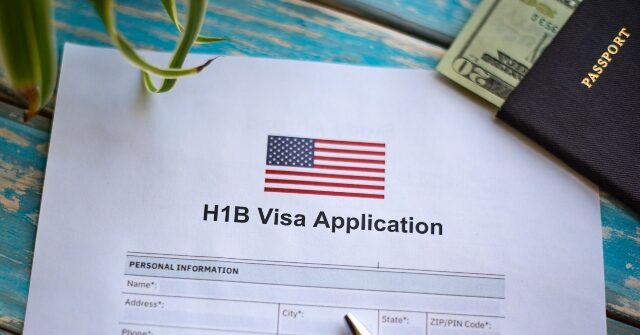A 44 percent plurality of likely voters say that companies exploit the H-1B visa system, according to a new poll by Cygnal.
Just 18 percent say “definitely H-1B visas are essential for U.S. competitiveness,” says the October 7-8 poll of 1,500 likely general-election voters.
The poll comes after President Donald Trump added a largely symbolic $100,000 fee for corporations seeking to import the mixed-skill H-1B workers, nearly all of whom are used to displace skilled and outspoken American professionals.
Since the announcement, Trump’s support has nudged up by three points among U.S. college graduates, the data shows.
The Cygnal survey suggests that opposition to H-1B outsourcing could be a big winner for the GOP once top leaders spotlight the extensive corruption and the pocketbook and economic damage within the visa programs.
For example, 43 percent of Cygnal’s subset of “swing voters” says companies exploit the program, while 35 percent say the visas are vital. Similarly, 50 percent support Trump’s imposition of the $100,000 fee, while 38 percent oppose the fee.
The damage caused by the H-1B and other visa programs has been hidden by establishment media. Even now, outlets such as Jeff Bezos’ Washington Post and the New York Times prefer to sympathize with illegal migrants instead of the millions of American white-collar voters who have lost jobs and careers to the visa outsourcing.
However, that media imbalance is being corrected by Breitbart News and by the rising number of online news sources reporting about the visa programs. “People are waking up,” one political strategist told Breitbart News.
President Trump and his deputies are also helping by showcasing the huge scale of visa migration and the alternative of greater productivity. On September 19, for example, Trump signed a proclamation saying:
Some employers, using practices now widely adopted by entire sectors, have abused the H-1B statute and its regulations to artificially suppress wages, resulting in a disadvantageous labor market for American citizens, while at the same time making it more difficult to attract and retain the highest skilled subset of temporary workers, with the largest impact seen in critical science, technology, engineering, and math (STEM) fields.
The number of foreign STEM workers in the United States has more than doubled between 2000 and 2019, increasing from 1.2 million to almost 2.5 million, while overall STEM employment has only increased 44.5 percent during that time. Among computer and math occupations, the foreign share of the workforce grew from 17.7 percent in 2000 to 26.1 percent in 2019. And the key facilitator for this influx of foreign STEM labor has been the abuse of the H-1B visa.
A September survey of white-collar professionals shows that 56 percent of U.S. citizens say the huge H-1B visa-worker program is transferring their jobs and careers to white-collar migrants. A long-standing survey by Rasmussen also shows 2:1 public opposition to “higher skill” visa outsourcing.
The Cygnal data shows that Democrats viscerally oppose Trump’s policy towards the H-1B program. For example, 62 percent of Democrats strongly oppose Trump’s $100,000 fee, while only two percent strongly support the fee. Twenty-eight percent of Democrats say the program is exploited, while 52 percent say it is essential.
India’s government strongly supports the flow of H-1B workers into U.S. jobs that would otherwise go to young Americans:
GOP supporters say the program is exploited by 61 to 25 percent.
Curiously, blue-collar workers are more skeptical of the H-1B program than the white-collar Americans who are the target of the H-1B outsourcing. For example, 55 percent of non-college Americans say the program is exploitative, versus 45 percent of college grads. Cygnal reported the class divide, saying:
Wealthy elites ($200K+) are the most likely to say H-1B visas are essential for competitiveness (52%; +20 net essential), while working-class Americans (<$75K) believe companies are exploiting the H-1B visa program (45%; +9 net exploit)
Read the full article here


